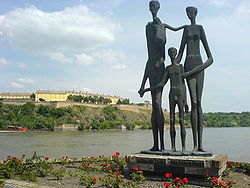Novi Sad
Novi Sad (Serbian Cyrillic: Нови Сад, pronounced [nɔ̝̂v̞iː sâːd] (![]() listen)) is the second largest city in Serbia. It is the capital of both Vojvodina[2] and the South Bačka District.
listen)) is the second largest city in Serbia. It is the capital of both Vojvodina[2] and the South Bačka District.
City | |
 | |
 Location of Novi Sad within Serbia | |
| Coordinates: 45°N 19°E / 45°N 19°ECoordinates: 45°N 19°E / 45°N 19°E | |
| Country | Serbia |
| Province | Vojvodina |
| District | South Bačka |
| Municipalities | 2 |
| Settled by Scordisci | 4th century B.C. |
| Founded | 1694 as Racki Grad (Serb City) |
| City status | 1 February 1748 as Novi Sad |
| Government | |
| • Mayor | Žarko Mićin (SNS) |
| Area | |
| • Novi Sad | 1,105 km2 (426.5 sq mi) |
| Elevation | 80 m (262 ft) |
| Population (2011) | |
| • Novi Sad | |
| • Density | 164.7/km2 (426.5/sq mi) |
| • Metro | |
| Time zone | UTC+1 (CET) |
| • Summer (DST) | UTC+2 (CEST) |
| Postal code | 21000 |
| Car plates | NS |
| Website | www.novisad.rs |
Novi Sad Media
Roman golden helmet, Museum of Vojvodina
Habsburgs prohibited Orthodox Christians to settle in Petrovaradin. That policy pushed Serbs to form the Serb city which later became Novi Sad. The city was proclaimed to be a free royal city by Maria Theresa by 1748.
Serb uprising of 1848–49, Serbian patriarch Josif Rajačić is giving a blessing to the army of Serbian Vojvodina in 1848.
Petrovaradin Podgrađe (Petrovaradin Inner City) and Petrovaradin Fortress, 1920s
Great Assembly of Serbs, Bunjevci, and other Slavs proclaimed the unification of Vojvodina region with the Kingdom of Serbia in Novi Sad in 1918.
Prince Tomislav Bridge, destroyed on 11 April 1941 by the Yugoslav army during the Invasion of Yugoslavia. The bridge was replaced by the Marshal Tito Bridge in 1945 and later Varadin Bridge in 2000.
"The Family" by Jovan Soldatović, Monument dedicated to the victims of the Novi Sad raid, which took place during the Hungarian occupation in WWII.
Novi Sad, Stari Grad (Old Town) panoramic view, 2022











